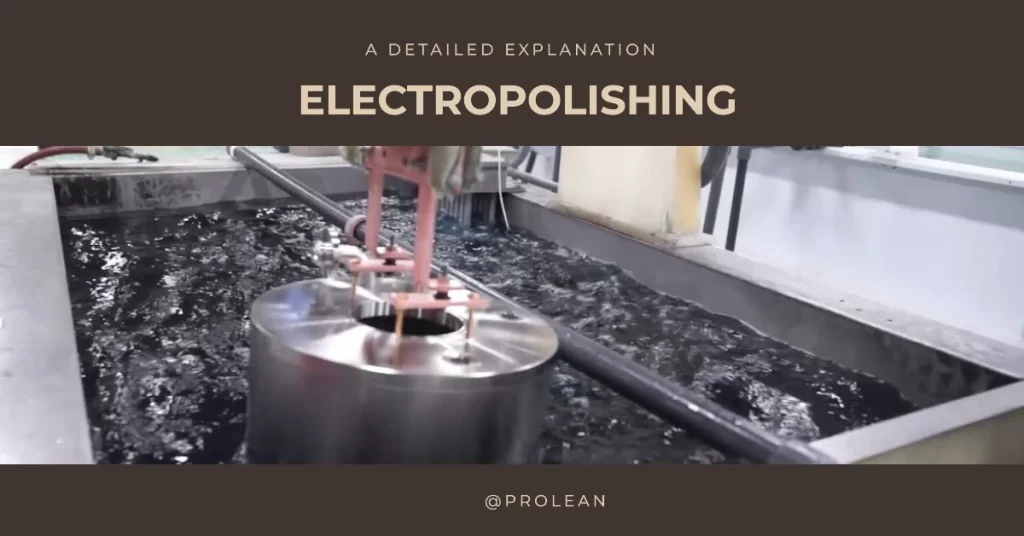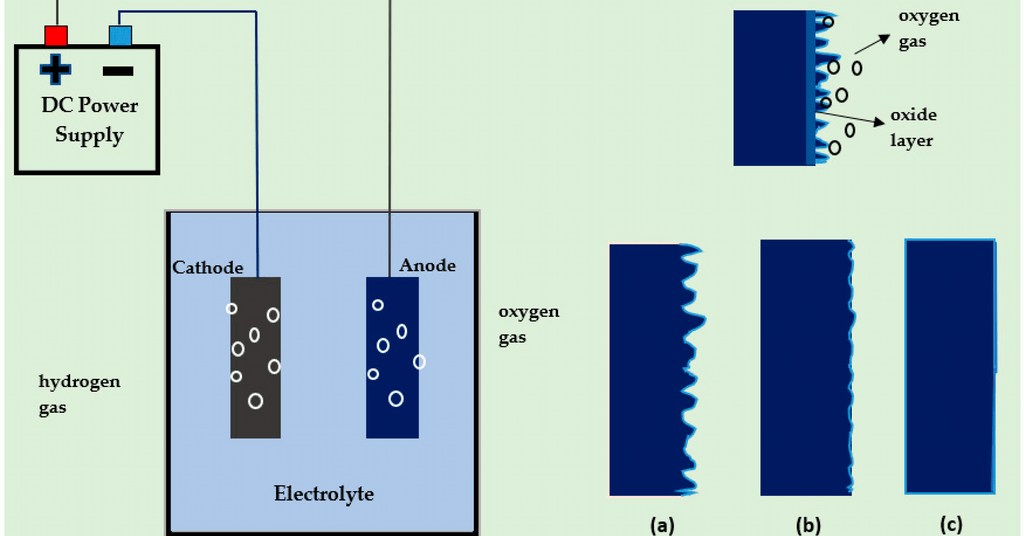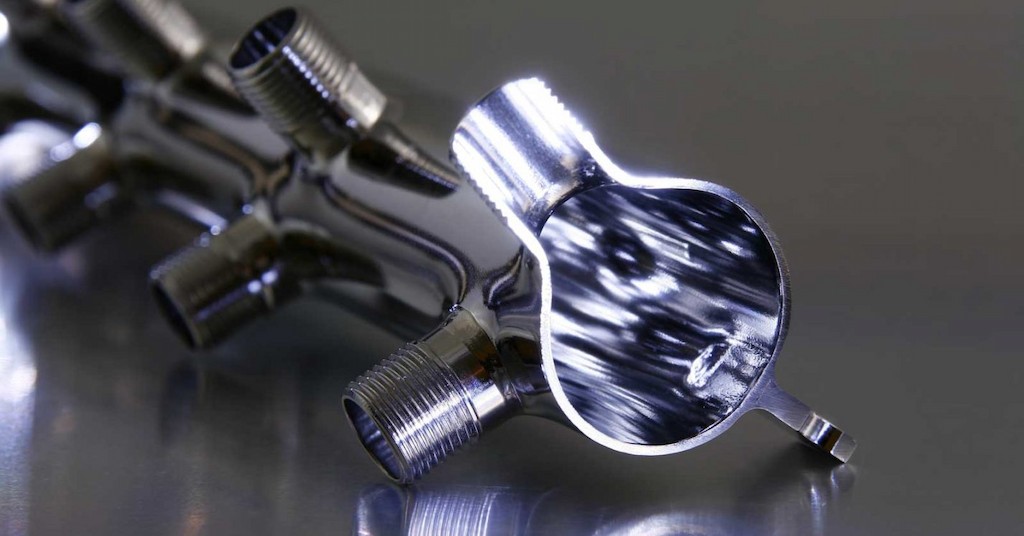“Electropolishing smooths and brightens metal surfaces by selectively removing material at the microscopic level. It enhances corrosion resistance, reduces surface roughness, and improves the appearance aesthetic”

The surface finish is essential in the manufacturing industry. The surface properties like roughness level, coefficient of friction, and uniformity directly affect the performance and functionality, whereas the surface appearance is important in terms of aesthetic beauty. Surface Polishing is a fine finishing technique that produces clean, smooth, and defect-free surfaces. You can apply polishing by mechanical and electrical means. Mechanical polishing uses sequential grinding with low to high grain size of abrasive. On the other hand, electropolishing involves an electrolysis process to remove the imperfections and irregularities from the workpiece surface.
In this article, we will discuss what is electropolishing in detail. It will guide you through the working principle, advantages, disadvantages, and applications.
What is Electroplishing?
Electropolishing refers to achieving a refined (often mirror-like) surface by removing a small layer of material from the surface with an electrolysis process, thickness ranges from 0.0003 to 0.0007″ (0.072 to 175 mm) based on the applied current and process time. The electrochemical process removes the microscopic defects, burrs, irregularities, and other imperfections to make the surface shiny, clean, and smooth. It can increase the original quality or smoothness by more than 50%. Meanwhile, it can achieve the roughness range
It is predominantly used in metal polishing as the electrochemical process is highly compatible with electrically conductive materials like stainless steel, copper, aluminum, titanium, brass, etc.
Furthermore, electrochemical polishing is also beneficial in protecting from operational conditions and the external environment. The polished surface when exposed to moisture, the outer layer acts as a barrier. Consequently, they are also suitable for any subsequent surface finishing process, if you need to enhance the quality and appearance —for example, plating, powder coating, painting, etc.
Try Prolean Now!
How Does Electropolishing Work?
As previously mentioned, electropolishing is an electrochemical surface finishing process. The working mechanism is based on the electrolysis principle. It says that the positively charged metal ions migrate from the anode to the negatively charged cathode, facilitating the uniform removal of material from the anode and deposition into the cathode.

Electropolishing mechanism
The electropolishing process uses workpieces as an anode (attached to rack structure inside the electrolysis tank. Meanwhile, other metals with high conductivity are used as cathodes. Here, the cathode metal attracts the metal ions from the workpiece surface, removing the layer of microscopic burrs, embedded particles, and sharp edges.
The table below shows the common electropolishing components;
| Component | Description |
| Anode | The workpiece, part needs to be electropolished |
| Cathode | A conductive material such as copper, stainless steel, or lead. |
| Rack | That attached or holds the workpieces |
| Electrolyte Solutions | Acidic solutions like a mixture of H₃PO₄ and H₂SO₄ |
| Current Density | 10 to 100 A/dm² |
| Voltage | Low voltages, typically range from 8 to 25 V |
The Step-by-Step Electropolishing Process
Next, the step-by-step processing is not as easy as it seems. It involves a series of stages from surface cleaning to post-dipping.
1. Surface Preparation
First, the surface of substrate workpieces needs to be thoroughly cleaned to remove excessive roughness, debris, oils, grease, and other contamination. Otherwise, a major contamination can affect the quality parameters like uniformity and roughness level.
Here is the process of surface preparation for the electropolishing process;
- Mechanical Abrasives: The higher surface roughness might need mechanical cleaning like grinding to prepare the surface.
- Degreasing: Use degreasing solutions like alkaline cleaner or ultrasonic cleaning to remove organic contamination, followed by rinsing to eliminate cleaner residues.
- Pickling: If necessary, apply pickling agents like hydrochloric acid or a proprietary pickling solution to remove the rust and oxides. Then, again apply the rinsing.
2.Electroplating Setup
Next, set the workpiece and cathode inside the electrolysis tank. Often, a rack structure holds multiple work parts. Meanwhile, use an electrolyte solution to immerse them, mostly an acidic solution mixture. You also need to connect the rack and cathode to a DC power source with a suitable voltage.
3. Electrochemical Process
Once the power supply is on, the metal ions from the workpiece (anode) dissolve into the electrolyte and move to the cathode, which means removing material from the high points on the surface. After continuing the process for a pre-determined time, it results in a polished finish. The temperature of electrochemical polishing ranges from 40 to 75 °C, whereas the process can last for 1 to 20 minutes.
Let’s see the how chemical reaction takes place inside the tank with an example of stainless steel electropolishing with a H₂SO₄ solution and copper cathode.
- At Workpiece or Anode: Fe(s) → Fe²⁺(aq) + 2e⁻ (Iron dissolution)
- At Cathode: Cu²⁺(aq) + 2e⁻ → Cu(s) (Copper plating
4. Post Treatment
Once the desired finish is achieved, remove the parts from the electrolysis setup and rinse them with warm water and a mild alkali dip to neutralize the acidic surface. You can use sodium carbonate or ammonia. Then, dry them with warm air or in the oven before conducting the quality-control inspections.
Which Materials Can be Electropolished?
Although stainless steel is the most common material, titanium polishing and other hard metals and alloys can be finished with an electropolishing process. It makes parts corrosion & wear resistance and also produces fine grain boundaries.
Electropolishing Stainless Steel
Stainless steel is the most common material used in electropolishing. Almost every stainless alloy can be polished with suitable electrochemical arrangement. Polishing protects the strength, hardness, and other properties. electropolishing stainless steel requires careful consideration of the mixture ratio of electrolytes ( H₃PO₄ and H₂SO). The reason is it is sensitive to composition and temperature.
Aluminum
The Electropolished aluminum surface becomes wear-resistant and corrosion-resistant, enhancing the durability of aluminum components further. The polishing process includes more dilute electrolytes than stainless steel. The final result of the aluminum surface after processing is a smooth and uniform matte finish, which can be further enhanced with additional steps.
Titanium
Titanium is a material with a high strength-to-weight ratio, corrosion resistance, and biocompatibility. Its parts can be electropolished to meet the surface finish and strict industry requirements. Instead of polish titanium with mechanical means, electropolishing can be applied for various applications. So, you can titanium electrochemical polish for microscopic surface refinement.
Copper
Copper and its alloys are known for their electrical and thermal conductivity, but these properties are reduced after electropolishing. Meanwhile, the electrolysis typically involves hydrofluoric acid (HF) and sulfuric acid (H₂SO₄). Consequently, copper electropolishing can be used to enhance biocompatibility and fatigue resistance in certain applications.
Other Materials
You can polish other several metals and alloys with an electrochemical process, including cobalt chrome, nickel alloys, brass, etc.
Try Prolean Now!
What are the Applications of Electropolishing?
Large material options are compatible with electropolish finishing and they can also achieve specific surface texture and roughness levels. As a reason, a wide range of parts and components can be finished with this technique.

Electropolished Part
The applications range from automotive components to tool and die polishing. Here is the table to demonstrate the application examples across different sectors.
| Industry | Why Use Electropolishing? | Application Examples |
| Medical | Electropolish improves cleanliness, biocompatibility, and corrosion resistance | Surgical instruments, stents, needles, medical devices |
| Automotive | It produces high-performance components as it reduces friction and corrosion | Fuel lines, gears, rims, grilles, exhaust components |
| Aerospace | For durable and reliable aerospace components | Turbine blades, wheels, impellers, vacuum chambers |
| Electronics & Communication | A polished surface ensures smooth and conductive surfaces, which is critical for sensitive equipment. | Various electronic and communication components |
| Semiconductor | It creates particle-free surfaces, ensuring high purity in gas transport | Pipework, valves for micro-chip manufacturing |
| Architectural | Provides aesthetic enhancement and protection from corrosion | Complex gates, exterior decorative components |
| Process Equipment | The manufacturing of low-friction, durable, and clean components | Heat exchangers, reactor vessels, storage tanks, pipes |
| Food & Beverage | It prevents product build-up and is easy to clean | Brewing vessels, food mixer blades |
Advantages of Electropolishing
There are many benefits of using an electropolishing process to finish metal alloys. First, electrolysis is not limited to complex and intricate features. There is no such thing as tool access areas during the process. Next, it eliminates all irregularities, including microscopic defects.
- Defects-free uniform surface
- It is not limited to any complex or small geometrical features
- Uniform material removal and fine-grain structure
- It increases the surface smoothness and reduces the coefficient of friction
- Protection against harsh environment and corrosion
- Better fatigue and wear resistance
- Attractive aesthetic appearance
- Cost-effective for small to medium volumes
Disadvantages of Electropolishing
It has some limitations or drawbacks too. The Electropolished surface can not achieve smoothness ( or roughness value) as high as some other surface treatments like polishing and electroplating. Consequently, you can only finish electrically conductive parts.
- Since the process utilizes acidic solutions, any residue can impact for a long time. Therefore, neutralization and cleaning are essential after polishing.
- It is relatively a time-consuming technique
- Any error in temperature, current, and concentration control can affect the material removal rate and uniformity in it.
- The rougher surfaces require mechanical grinding or polishing before applying the electropolishing finish.
Try Prolean Now!
How to Choose the Right Electropolishing Service Provider?
Since there are a lot of online electropolishing services, it could be confusing how to choose a reliable company that can meet your surface finishing requirements. For this, you first need to list all of the requirements and look for the services that have technical capabilities to meet them. Subsequently, the lead time, cost, and similar experience also need to be considered.
ProleanTech is a leading company in the field of surface finishing, including mechanical polishing and electropolishing. Our advanced surface treatment factory has numerous polishing equipment and quality control instruments. We are flexible.
Furthermore, our decade of experience in manufacturing and surface finishing for diverse industrial projects might help you achieve your surface specifications. So, request a quote for Polishing Service Today!
Key Takeaways:
- Electropolishing removes the thin film of the material surface using an electrochemical reaction to remove all defects and burrs.
- The right current, voltage, and temperature are necessary for optimal polishing results.
- The Electropolish can be used for stainless steel, copper, aluminum, titanium, and other countless metals and alloys.
- Its benefits are useful in industries like automotive, aerospace, tool & die, medical, electronics, etc.
- Lastly, consider the capabilities and experience of surface treatment companies to choose the right service provider.




0 Comments